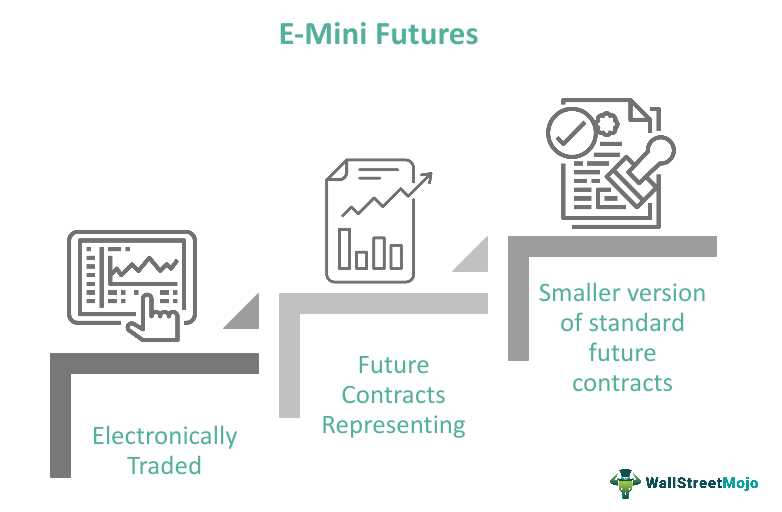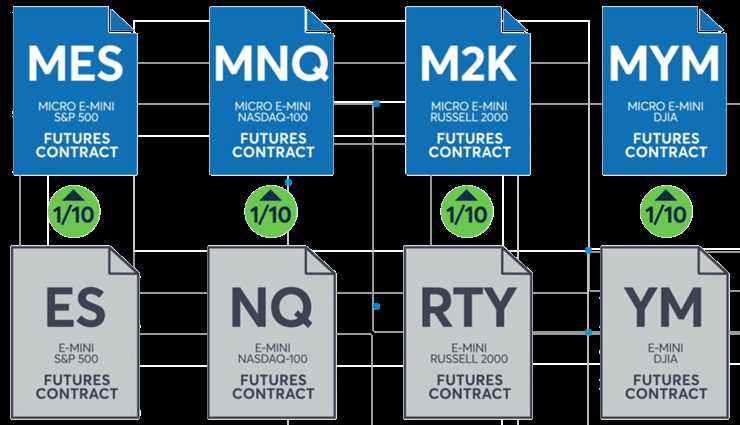E-Mini Trading: Definition and Applications in Futures Trading
Unlike traditional futures contracts, which are traded in open outcry pits, E-Minis are traded electronically, allowing for faster execution and greater liquidity. This makes them an attractive option for both individual traders and institutional investors.
E-Minis are available for a wide range of underlying assets, including stock indices, commodities, and currencies. Some of the most popular E-Mini contracts include the E-Mini S&P 500, E-Mini Nasdaq 100, and E-Mini Dow Jones Industrial Average.
E-Mini trading can be done using a variety of strategies, including day trading, swing trading, and trend following. Traders can use technical analysis tools and indicators to identify potential entry and exit points, as well as to manage risk.
E-Mini trading offers several advantages over traditional futures trading. First, it allows traders to participate in the futures market with a smaller capital requirement. Since E-Minis are smaller in size, the margin requirements are also lower, making it more accessible to individual traders.
Another advantage of E-Mini trading is the liquidity of these contracts. Due to their popularity and electronic nature, E-Minis tend to have high trading volumes, which means that traders can enter and exit positions quickly and at competitive prices.
Furthermore, E-Mini trading provides traders with the ability to hedge their existing positions in the underlying asset or index. For example, if a trader owns a portfolio of stocks and wants to protect against a potential market downturn, they can sell E-Mini contracts on a stock market index to offset any potential losses.
Types of E-Mini Trading Strategies
There are several strategies that traders can employ when trading E-Minis. One common strategy is trend following, where traders identify and follow the prevailing trend in the market. This strategy involves buying E-Mini contracts when prices are rising and selling when prices are falling.
Another popular strategy is mean reversion, which involves identifying overbought or oversold conditions in the market and taking positions opposite to the prevailing trend. This strategy assumes that prices will eventually revert to their mean or average levels.
Additionally, some traders use technical analysis tools and indicators to make trading decisions. These tools can help identify patterns, trends, and support and resistance levels in the market, which can be used to determine entry and exit points.
Education and Resources for E-Mini Trading
For those interested in learning more about E-Mini trading, there are numerous educational resources available. Online courses, webinars, and tutorials can provide traders with a solid foundation in E-Mini trading strategies and techniques.
In addition to educational resources, traders can also benefit from using trading platforms that offer advanced charting and analysis tools. These platforms provide real-time market data and allow traders to execute trades directly from the charts.
Furthermore, it is essential for traders to stay updated on market news and developments that may impact the price of the underlying assets or indexes. Financial news websites, market analysis reports, and economic calendars can provide valuable insights and help traders make informed trading decisions.
Benefits of E-Mini Trading
E-Mini trading offers several benefits for traders looking to participate in futures markets. These benefits include:
1. Lower Capital Requirements:
One of the main advantages of E-Mini trading is that it requires lower capital compared to trading full-sized contracts. This makes it more accessible for individual traders with limited funds. Traders can enter and exit positions with smaller amounts of capital, allowing them to manage risk more effectively.
2. Diversification:
E-Mini contracts are available for various asset classes, including stock indices, commodities, and currencies. This allows traders to diversify their portfolios and spread their risk across different markets. By trading E-Mini contracts, traders can gain exposure to a wide range of markets without the need for multiple trading accounts.
3. Liquidity:
E-Mini contracts are highly liquid, meaning there is a large number of buyers and sellers in the market. This high level of liquidity ensures that traders can enter and exit positions quickly and at competitive prices. It also reduces the risk of slippage, which is the difference between the expected price and the actual execution price.
4. Flexibility in Trading Hours:
E-Mini contracts trade on electronic platforms, allowing traders to access the market outside of regular trading hours. This flexibility is particularly beneficial for traders in different time zones or those who have other commitments during regular trading hours. It enables them to trade at their convenience and take advantage of market opportunities whenever they arise.
5. Lower Transaction Costs:
Compared to trading full-sized contracts, E-Mini trading typically incurs lower transaction costs. This is because E-Mini contracts have smaller contract sizes, resulting in lower commission fees. Lower transaction costs can significantly impact a trader’s profitability, especially for high-frequency traders who execute a large number of trades.
6. Access to Professional Trading Tools:
E-Mini trading platforms often provide traders with access to advanced trading tools and analytics. These tools can help traders analyze market trends, identify trading opportunities, and manage risk effectively. Professional trading tools can give traders a competitive edge and enhance their overall trading performance.
Strategies for E-Mini Trading

1. Trend Following
One popular strategy in e-mini trading is trend following. This strategy involves identifying the overall trend in the market and trading in the direction of that trend. Traders using this strategy will look for opportunities to enter trades when the market is trending up or down, and exit when the trend starts to reverse.
There are various technical indicators that can be used to identify trends, such as moving averages or trend lines. Traders can also use chart patterns, such as higher highs and higher lows in an uptrend, to confirm the trend and make trading decisions.
2. Breakout Trading

Another strategy commonly used in e-mini trading is breakout trading. This strategy involves entering trades when the price breaks out of a defined range or level of support/resistance. Traders using this strategy will wait for a breakout to occur, and then enter a trade in the direction of the breakout.
Breakout traders will often use technical indicators, such as Bollinger Bands or Donchian Channels, to identify potential breakout levels. They will also look for confirmation signals, such as increased volume or a strong price move, to validate the breakout and increase the probability of a successful trade.
3. Scalping
Scalping is a short-term trading strategy that can be applied in e-mini trading. This strategy involves taking small profits from quick trades, often within minutes or seconds. Scalpers will look for opportunities to enter and exit trades rapidly, taking advantage of small price movements.
Scalpers often use technical indicators, such as moving averages or oscillators, to identify short-term price fluctuations and determine entry and exit points. They will also closely monitor market liquidity and order flow to ensure they can execute trades quickly and efficiently.
Educational Resources for E-Mini Trading
- Online Courses: Many online platforms offer courses specifically designed for E-Mini trading. These courses cover various topics such as technical analysis, risk management, and trading strategies. They often include video tutorials, quizzes, and interactive exercises to help you grasp the concepts effectively.
- Webinars: Webinars are live online seminars conducted by experienced traders and industry experts. They provide valuable insights and practical tips on E-Mini trading. Webinars often include real-time market analysis, trading demonstrations, and Q&A sessions, allowing you to learn directly from professionals in the field.
- Books and eBooks: There are numerous books and eBooks available that cover different aspects of E-Mini trading. These resources range from beginner-friendly guides to advanced technical analysis books. Reading books written by successful traders can provide you with valuable insights and strategies that you can apply to your own trading.
- Online Forums and Communities: Engaging with other traders through online forums and communities can be a great way to learn from their experiences and share your own insights. These platforms allow you to ask questions, discuss trading strategies, and stay updated with the latest trends in E-Mini trading.
- Trading Mentors: Finding a trading mentor who has experience in E-Mini trading can be invaluable. A mentor can provide personalized guidance, share their trading strategies, and help you navigate the complexities of the market. They can also provide feedback on your trades and help you identify areas for improvement.

Emily Bibb simplifies finance through bestselling books and articles, bridging complex concepts for everyday understanding. Engaging audiences via social media, she shares insights for financial success. Active in seminars and philanthropy, Bibb aims to create a more financially informed society, driven by her passion for empowering others.
